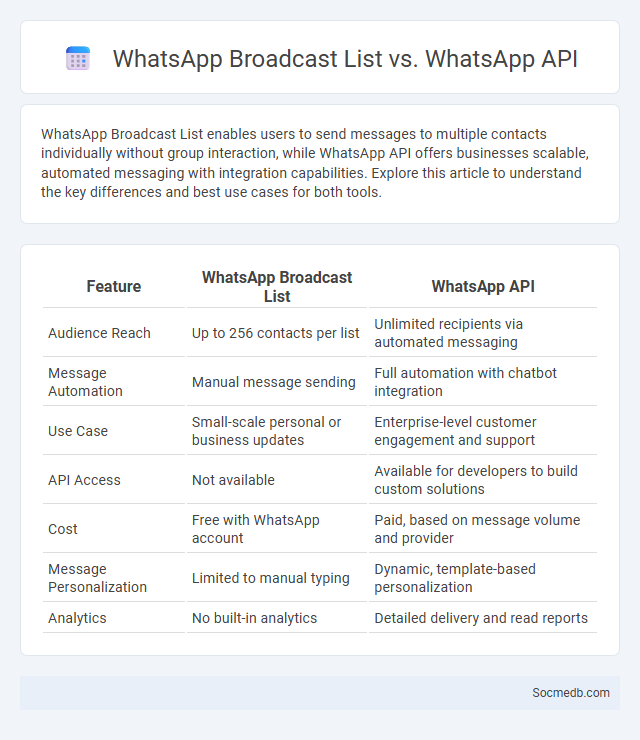
Photo illustration: WhatsApp Broadcast List vs WhatsApp API
WhatsApp Broadcast List enables users to send messages to multiple contacts individually without group interaction, while WhatsApp API offers businesses scalable, automated messaging with integration capabilities. Explore this article to understand the key differences and best use cases for both tools.
Table of Comparison
| Feature | WhatsApp Broadcast List | WhatsApp API |
|---|---|---|
| Audience Reach | Up to 256 contacts per list | Unlimited recipients via automated messaging |
| Message Automation | Manual message sending | Full automation with chatbot integration |
| Use Case | Small-scale personal or business updates | Enterprise-level customer engagement and support |
| API Access | Not available | Available for developers to build custom solutions |
| Cost | Free with WhatsApp account | Paid, based on message volume and provider |
| Message Personalization | Limited to manual typing | Dynamic, template-based personalization |
| Analytics | No built-in analytics | Detailed delivery and read reports |
Introduction to WhatsApp Broadcast List and WhatsApp API
WhatsApp Broadcast List allows you to send messages to multiple contacts simultaneously without creating a group, ensuring personalized communication with your audience. WhatsApp API enables businesses to automate messaging, integrate customer support, and manage large-scale interactions efficiently. Leveraging these tools can enhance your customer engagement and streamline communication strategies on WhatsApp.
Key Differences Between WhatsApp Broadcast List and API
WhatsApp Broadcast List enables You to send messages simultaneously to multiple contacts without revealing recipient identities, ideal for small-scale personal or business communication. In contrast, WhatsApp API supports automated, large-scale messaging with integration into CRM systems, providing advanced features like message templates, secure authentication, and analytics for enterprise-level engagement. The Broadcast List is limited to contacts who have saved your number and is user-friendly, while the API requires technical setup and approval but offers scalable, personalized interactions vital for business growth.
What is a WhatsApp Broadcast List?
A WhatsApp Broadcast List allows users to send a message to multiple contacts simultaneously without creating a group chat, preserving individual privacy. Messages sent via broadcast lists appear as standard individual chats to recipients, ensuring personalized communication. This feature is widely used for marketing, updates, and announcements to efficiently reach large audiences on the platform.
What is WhatsApp API?
WhatsApp API is a powerful tool designed for businesses to integrate WhatsApp messaging into their communication systems, enabling automated, scalable customer interactions. It supports sending notifications, customer support messages, and interactive user experiences with secure, encrypted messaging. By leveraging WhatsApp API, companies enhance engagement, streamline customer service, and improve response times on the world's most popular messaging platform.
Features Comparison: Broadcast List vs WhatsApp API
Broadcast List enables users to send messages to multiple contacts individually without exposing recipients to each other, ideal for small-scale communications with up to 256 contacts per list. WhatsApp API supports large-scale, automated messaging for businesses, offering features like template messages, integration with CRM systems, and interactive notifications. The API ensures higher delivery reliability, analytics tracking, and compliance with WhatsApp's business policies, making it suitable for complex customer engagement scenarios.
Use Cases for WhatsApp Broadcast Lists
WhatsApp Broadcast Lists enable businesses to efficiently send promotional messages, updates, and customer service notifications to multiple contacts simultaneously without creating group chats. This feature supports targeted marketing campaigns by allowing personalized communication while maintaining recipient privacy, increasing engagement rates. It is widely used for event invitations, product launches, and timely alerts, enhancing customer relationship management through direct and discreet messaging.
Use Cases for WhatsApp API
WhatsApp API enables businesses to streamline customer support by automating responses and managing high volumes of inquiries efficiently. Companies leverage the API for personalized marketing campaigns, sending notifications, appointment reminders, and transactional alerts in real-time. Integration with CRM systems allows seamless management of customer interactions, enhancing engagement and boosting conversion rates.
Pros and Cons of WhatsApp Broadcast Lists
WhatsApp Broadcast Lists enable users to send messages simultaneously to multiple contacts without creating a group, enhancing privacy and personalized communication for businesses and individuals. However, recipients receive broadcasts as individual messages, which can limit engagement and feedback compared to group chats, and overuse may lead to message fatigue or be perceived as spam. The feature supports efficient information dissemination but requires careful management to maintain audience trust and avoid communication overload.
Pros and Cons of WhatsApp API
WhatsApp API offers businesses efficient customer communication through automated messaging, seamless integration with CRM systems, and enhanced user engagement, boosting customer satisfaction and operational productivity. However, using WhatsApp API may involve challenges such as compliance with strict data privacy regulations, potential high costs for large-scale messaging, and limitations in customization compared to other messaging platforms. By leveraging WhatsApp API strategically, your business can enhance real-time communication while navigating these constraints effectively.
Choosing the Right Solution: Broadcast List or WhatsApp API
Choosing between a Broadcast List and WhatsApp API hinges on the scale and complexity of communication needs for businesses on social media platforms. Broadcast Lists offer a simple, cost-effective way to send messages to up to 256 contacts simultaneously, ideal for small to medium-sized enterprises seeking personalized engagement. In contrast, WhatsApp API supports automation, integration with CRM systems, and bulk messaging capabilities, making it a preferred solution for large businesses aiming to streamline customer support and marketing campaigns.
 socmedb.com
socmedb.com